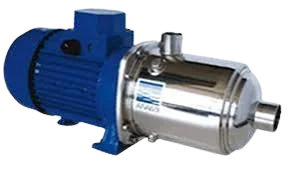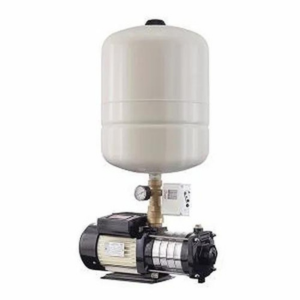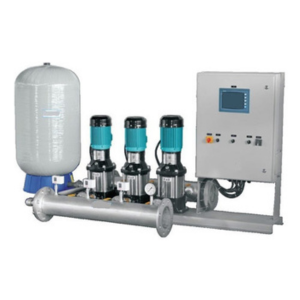
Water Pressure Booster Pumps for Industrial Units
Are you experiencing low water pressure in your homes? We provide best pressure water pressure booster pump cost effectively and energy efficient.
Water Pressure Booster Pumps for Industrial Units
Are you experiencing low water pressure in your homes? We provide best pressure water pressure booster pump cost effectively and energy efficient.
Water Pressure Booster Pump For Industrial Units
Multi-Stage Pressure Booster Pump
Centrifugal Pressure Booster Pump
Centrifugal Pressure Booster Pump
Centrifugal pressure booster pumps utilize a spinning impeller to increase water pressure. These versatile pumps are commonly used for general water supply and irrigation applications.
Working Principle:
As the impeller rotates, it imparts kinetic energy to the water, which is then converted into pressure energy as it exits the pump.
Specifications Table:
| Parameter | Specification |
| Flow Rate | Varies based on mode |
| Pressure Increase | Depends on impeller design |
| Application | General water supply, irrigation |
| Power Source | Electric motor |
| Efficiency | Moderate to high |
| Maintenance | Relatively low |
Multi-Stage Pressure Booster Pump
Multi-Stage Pressure Booster Pump
Multi-stage pressure booster pumps have multiple impellers arranged in series to achieve higher pressure levels. They are often used in high-rise buildings and industrial systems.
Working Principle:
Water passes through each impeller stage, gaining additional pressure before exiting the pump. This staged approach results in significant pressure boosts.
Specifications:
| Parameter | Specification |
| Flow Rate | Varies based on mode |
| Pressure Increase | High, with multiple stages |
| Application | High-rise buildings, industrial systems |
| Power Source | Electric motor |
| Efficiency | High |
| Maintenance | Periodic inspection and maintenance |
Industrial Pressure Booster Pump Applications
Industrial pressure booster pumps are critical in various industrial applications where maintaining consistent and reliable water pressure is essential. Here are some common applications and considerations for selecting the right pressure booster pump in industrial settings:
Common Applications
1.Manufacturing Facilities
-
- Process Water Supply: Ensuring consistent water pressure for manufacturing processes.
- Cooling Systems: Supplying water to cooling towers and heat exchangers.
2.High-Rise Buildings
-
- Domestic Water Supply: Providing adequate water pressure for all floors.
- Fire Suppression Systems: Ensuring reliable pressure for fire sprinklers and hydrants.
3.Agriculture and Irrigation
-
- Crop Irrigation: Maintaining consistent water pressure for sprinkler and drip irrigation systems.
- Livestock Watering: Ensuring adequate water pressure for livestock watering systems.
4.Municipal Water Supply
-
- Water Distribution: Boosting water pressure in municipal water supply networks.
- Wastewater Treatment: Providing consistent pressure for various treatment processes.
5.Food and Beverage Industry
-
- Process Water Supply: Ensuring consistent pressure for cleaning, processing, and packaging.
- CIP (Clean-In-Place) Systems: Maintaining pressure for automated cleaning systems.
6.HVAC Systems
-
- Chilled Water Systems: Supplying water to HVAC systems for cooling and heating.
- Boiler Feed Water: Maintaining pressure for boiler systems in heating applications.
7.Mining and Construction
-
- Dust Suppression: Providing water pressure for dust control systems.
- Site Water Supply: Ensuring water pressure for various site needs, including concrete mixing and washing
Key Considerations
1.Flow Rate and Pressure Requirements
-
- Peak Demand: Determine the maximum flow rate and pressure required during peak usage.
- System Head: Calculate the total dynamic head (TDH) considering vertical lift, friction losses, and pressure requirements.
2.Pump Type
-
- Centrifugal Pumps: Common for high flow rates and moderate pressure.
- Positive Displacement Pumps: Suitable for precise flow rates and high pressure.
- Vertical Multi-Stage Pumps: Efficient for high-pressure applications in limited space.
3.Material Compatibility
-
- Corrosion Resistance: Ensure pump materials are compatible with the water or fluid being pumped.
- Durability: Choose materials that can withstand harsh industrial environments.
4.Energy Efficiency
-
- Variable Speed Drives (VSD): Implement VSDs to adjust pump speed based on demand, improving energy efficiency.
- High-Efficiency Motors: Select pumps with energy-efficient motors to reduce operating costs.
5.Control and Automation
-
- Smart Controllers: Use advanced controllers for monitoring and adjusting pump operation.
- Remote Monitoring: Implement systems for remote monitoring and control to ensure optimal performance.
6.Redundancy and Reliability
-
- Backup Pumps: Incorporate redundant pumps to ensure continuous operation in case of primary pump failure.
- Maintenance Access: Design the system for easy access to pumps for maintenance and repairs.
7.Noise and Vibration Control
-
- Noise Reduction: Choose pumps with noise-reducing features or install soundproofing measures.
- Vibration Dampening: Implement vibration dampening systems to protect pumps and piping.
FAQ
How do you increase water pressure in a commercial?
Booster pumps are installed in commercial buildings’ water systems to increase water pressure as it travels upwards. These pumps work by adding pressure to the water as it flows through the pipes.
What size water pressure booster pump do I need?
When sizing a domestic booster pump, you need to measure the current water pressure against the amount of pressure that the booster pump can provide. For instance, a building looking to boost water pressure from 20 to 40 psi will require a booster pump capable of producing 20 psi.
Are pressure booster pumps easy to install?
Most pressure booster pumps can be installed by a skilled plumber or technician. However, the complexity of installation can vary depending on the pump type and your specific plumbing setup. Professional installation is often recommended to ensure proper functioning and safety.
Do pressure booster pumps consume a lot of electricity?
The energy consumption of pressure booster pumps varies depending on the type and size of the pump, as well as usage patterns. Variable speed pumps tend to be more energy-efficient since they can adjust their speed according to demand, saving electricity when water usage is low.
How do I maintain a pressure booster pump?
Regular maintenance is essential to keep your pressure booster pump operating efficiently. This includes checking for leaks, inspecting and cleaning filters, lubricating moving parts (if applicable), and ensuring electrical connections are secure. Refer to the manufacturer’s guidelines for specific maintenance instructions.
What should I do if my pressure booster pump is making unusual noises or not working correctly?
If you notice unusual noises or a drop in performance, it’s important to contact a professional technician or plumber to diagnose and repair any issues promptly. Delaying repairs can lead to more significant problems.


